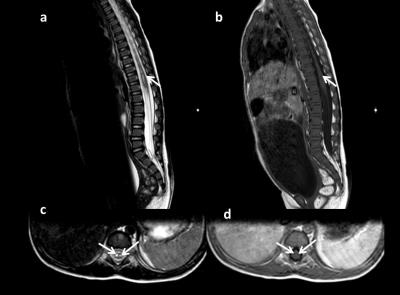2308
MRI characteristics predicts clinical outcomes in severe hand, foot, and mouth disease:analysis of 412 children in China1Guangdong Academy of Medical Sciences/Guangdong General Hospital, Guangzhou, People's Republic of China, 2Guangdong Academy of Medical Sciences/Guangdong General Hospital, People's Republic of China
Synopsis
Most severe hand, foot, and mouth disease(HFMD) are caused by EV71 infections, which can result in central nervous system complications. So magnetic resonance imaging (MRI) acquisition is important for the patients with EV71 infection to reveal the location of lesions and select the potential severe cases with poor prognosis. We aim to reviewed MRI characteristics of the severe HFMD, using a multivariate approach to compare the prognosis of different lesion sites based on a large cohort with follow-up. Our findings suggested lesions located in medulla oblongata (P<0.015)and spinal cord(P<0.001) on MRI associated with poor prognosis.
Purpose:
To investigate the prognostic factors for hand, foot and mouth disease (HFMD) based on MR characteristics with follow-up.Methods:
People. Between January 2009 and December 2014, 412 severe HFMD with virus-culture confirmed HFMD were enrolled. The severe case is determined on the basis of the Chinese guideline for HFMD diagnosis and treatment (Chinese Ministry of Public Health, revised in2010(1) MRI. Most MR scan were performed using a 1.5-T MRI (GyroscanAchieva 1.5T, Philips Healthcare, Best, Netherlands) equipped with an 8-channel head coil. Remaining MR examinations were performed using a 1.5-T MRI (Signa Excite HD, GE Healthcare, Milwaukee, WI, USA) equipped with an 8-channel head coil. Statistics. According to the prognosis good or poor, two groups were categorized. The student’ s t test was used to analyze continuous variables of the two groups based on results from the normality test and homogeneity test of variance. We used the chi squared test to analyze dichotomous variables. After univariate analysis had been performed for all possible factors, a multiple logistic regression analysis was conducted to examine the adjusted odds ratios (ORs) for those significant factors in univariate analysis.Methods:
Results: 174(42.2%) cases showed positive lesions located in different sites on MR. Of the 93 cases, 86(94.5%) located in the dorsal brainstem, 66 involved medulla oblongata. 412 patients were divided into two groups based on good or poor prognosis. Compared with the group with good prognosis. There were a significantly higher rate of lesions involving the cerebral white substance (P=0.011), thalamus(P=0.006), medulla oblongata(P<0.001), pons (P=0.004), midbrain(P=0.006) and spinal cord(P<0.001) in the group of poor prognosis. After screening clinical and laboratory parameters by using multivariate analysis (Table 2), we identified two risk factors may predict poor prognosis: lesions located in medulla oblongata(Figure 1) (P<0.015) and spinal cord(Figure 2) (P<0.001). the latter was the most significant prognostic factor (OR ratio 29.11, P<0.001). Figure 2. A 16 month boy suffering from EV71 with poor prognosis, he manifested decreased muscle strength in bilateral lower limbs in the follow-up. (a) Sigital T2WI reveals high signal intensity in the inferior thoracic segments(arrows). (b) T1WI demonstrates slightly low signal intensity(arrows).Axial images showed hyperintense symmetrical lesions in the anterior horn regions on T2WI and T1WI. Discussion: Previous studies, largely from China, have been performed to identify risk factors associated with severe HFMD(2) by baseline clinical and experimental results, but there is lack of MRI acquisition and follow-ups. The strengths of this study are the relatively large study population, using MRI characteristics, which is more objective, to predict prognosis of severe HFMD based on follow-up. In our study, we identified 2 independent risk factors associated with poor prognosis.Conclusion:
our results suggest that children who have severe HFMD with lesions located in medulla oblongata and spinal cord maybe close monitored for early intervention, especially for children with spinal cord damage, should be performed early rehabilitation treatment. The clinical symptoms and MR results have good consistency, for the children with the symptom of nervous system, it is strongly recommended for the MR examinationAcknowledgements
This work is supported by the National Scientific Foundation of China (grant 81171329, 81571664) and Guangdong science Foundation (grant 2014A020212244).References
(1)The Ministry of Health of the People's Republic of China. The national statutory epidemic situation of infectious diseases in 2014.available:http://www.moh.gov.cn/jkj/s3578/201502/847c041a3bac4c3e844f17309be0cabd.shtml. Accessed 29 March 2015. (2) Li W, Teng G, Tong H, et al. Study on risk factors for severe hand, foot and mouth disease in China. Plos One. 2014; 9: e87603.Figures

Figure 2. A 16 month boy suffering from EV71 with poor prognosis, he manifested decreased muscle strength in bilateral lower limbs in the follow-up. (a) Sigital T2WI reveals high signal intensity in the inferior thoracic segments(arrows). (b) T1WI demonstrates slightly low signal intensity(arrows).Axial images showed hyperintense symmetrical lesions in the anterior horn regions on T2WI and T1WI.